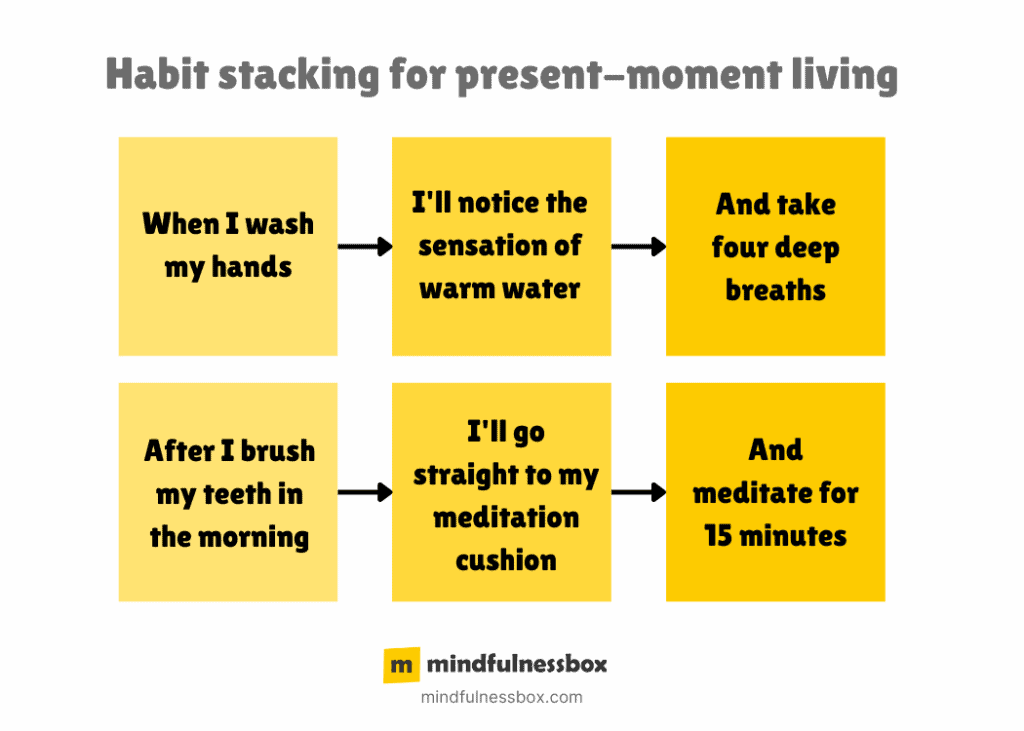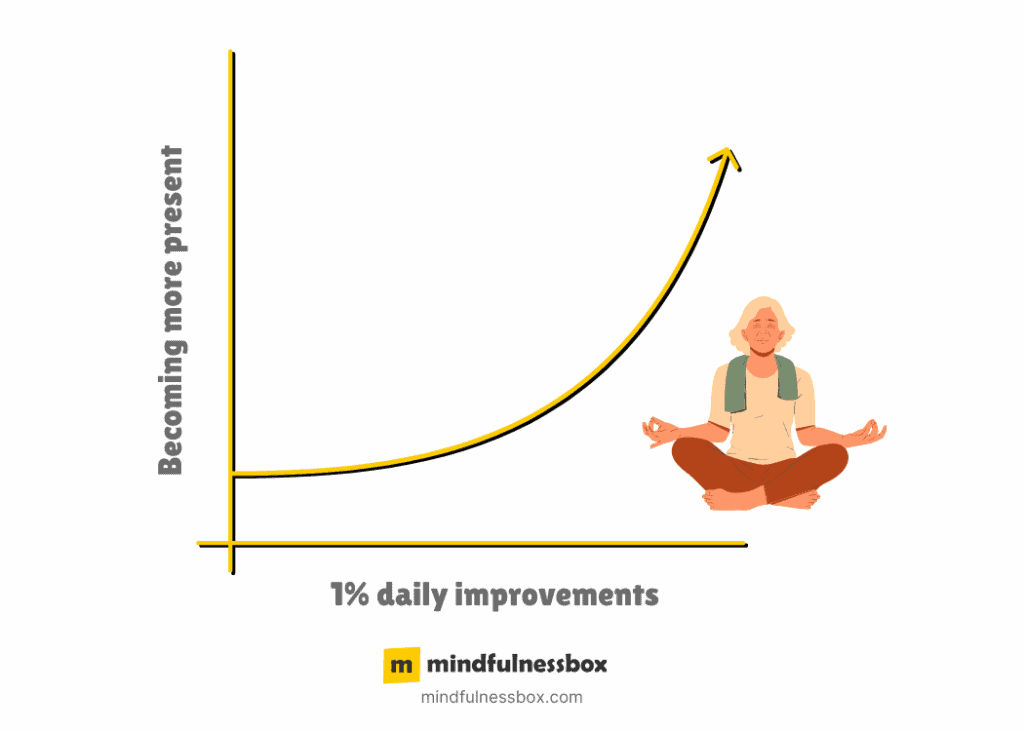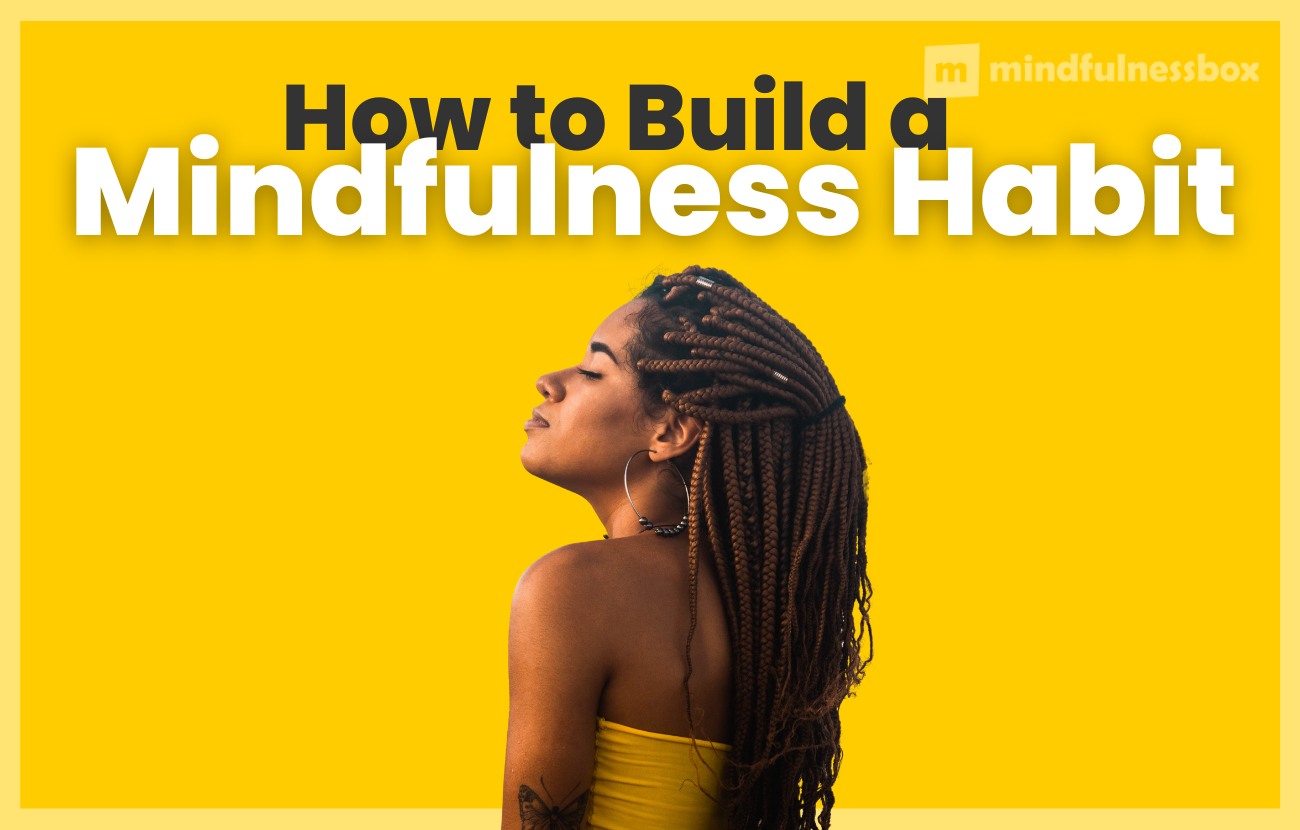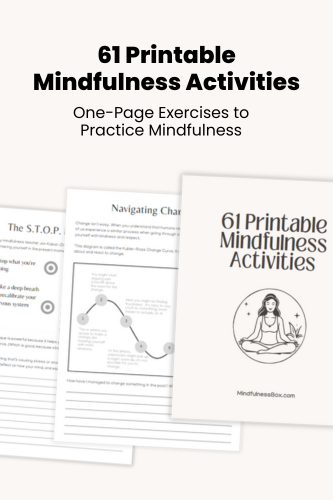If you’re wondering how to build a mindfulness habit, there’s no switch you can flip for instant results. Instead, being more present and mindful is a matter of improving a little every day. While imperceptible in the moment, this has enormous impact over time.
Like going to the gym, learning to be more mindful is a game of slow-and-steady.
The payoff often doesn’t show up until much later. But training consistently over time transforms you over years.
Get dozens of one-page exercises to help practice mindfulness, meditation, gratitude, and self love. Perfect for printable handouts when teaching mindfulness to groups, students, or in the workplace.
To see examples, plus a full list of the 61 exercises included, click below.
Sometimes it can feel like you’re doing everything you can to live more mindfully, but you’re not noticing any changes within yourself.
I know that happens to me. I’ll come across a new concept I want to internalize, and in the moment, it’ll seem like just what I needed. Gratitude, for example, or self-compassion.
But weeks go by, or months, it feels like I’m behaving the same way. Still forgetting to be grateful for what I have. Still forgetting to treat myself with care, the same way I’d treat a dear friend.
Then all of a sudden, maybe a year or two later, I’ll realize that something DID click, after all.
But I only see this in retrospect.
Two ways to make mindfulness a daily habit
When things take a long time, it can be demotivating. You can even start to question if your efforts are worth it, because the outcome feels the same as if you’d done nothing.
If you’re still feeling anxiety and stress at the same levels you felt before, why keep meditating?
If you’re still living most of your life in the past or the future, why bother with keeping up your mindfulness practice?
This is a challenge we all face. And unfortunately, there are no shortcuts.
Rewiring your brain for peace, gratitude, self-compassion, and present-moment living is the work of a lifetime.
But changing how you think about this process can help.
1. Use habit stacking to connect mindful habits to existing habits
If you’re interested in being more present, the next obvious question is “How do I do that?”
Mindfulness has plenty of tools to build present-moment awareness, from meditation to gratitude to yoga.
Still, change takes time. But your ability and willingness to practice is closely tied to your daily habits.
That’s why I think habit stacking is one of the more powerful ways to accelerate your mindfulness practice, especially if you feel like you’re not able to make time for mindfulness in your day-to-day life.
Habit stacking is a concept I learned from James Clear, who describes the full premise here.
The idea is that building habits is hard and takes work, but that you can make the process easier by linking new habits to ones that are already second nature to you.
For example, instead of saying “I’ll meditate every day,” you might say: “I’ll meditate for 15 minutes every day right after I brush my teeth.”
If brushing your teeth is already an established habit for you, you’ll find you’re able to hook your meditation habit onto your teeth-brushing habit.
In my view, this is even more powerful with mindfulness in your daily life.
Because the practice of meditation is about bringing your full attention to the present moment nonjudgmentally, that means you can get an incredible amount of mindfulness practice during the course of your day.
You can continue to train your muscle of present-moment attention long after you’ve left the meditation cushion.

Habit stacking can help you build small moments of mindfulness into your day.
For example:
- Wash your hands -> Mindful moment: When you wash your hands after going to the bathroom, you usually look at yourself in the mirror. Use that action to remind yourself to be present, feeling the temperature of the water, and moving intentionally as you put soap on your hands, run them under the water and dry them.
- Sit down in the car -> Take a breath and check in with yourself: When you sit down in the car and strap your seatbelt on, use that action to remind yourself to take a breath and focus on the present moment, not just the destination. How are you feeling right now? How can you conduct this trip in a way that contributes to a calmer day, so you show up to your destination refreshed?
- Clean up around the house -> Focus on nonjudgment: When you clean up around the house, you might be focused on wishing there wasn’t a mess to clean up. The fact that the action of cleaning up triggers this feeling means you can let yourself feel that judgment you normally feel, and then use it as a reminder to practice nonjudgment while cleaning. The resistance you feel can be an invitation to practice mindfulness.
2. Focus on gradual change rather than radical change
Improving 1% every day, while imperceptible in the moment (and perhaps a bit boring), has enormous impact over time.
If you could chart your “mindful moments,” they’d probably look like this: imperceptible progress at the beginning, eventually followed by a sudden realization that big change has happened.

This is the power of compound improvement.
All of a sudden, those tiny changes that have been adding up over time turn into a wave of powerful transformation.
Now, this doesn’t mean that you’re guaranteed to notice exponential growth in your mindfulness practice. Rather, my point is that the changes to the patterns in your mind are often imperceptible on the scale of a day, a week, a month, or even a year.
Forgive me as I quote Bill Gates, the founder of Microsoft, on a mindfulness website, but the following quote has become known as Gates’ Law:
“Most people overestimate what they can achieve in a year and underestimate what they can achieve in ten years.”
Bill Gates
We like to think that a 30-day meditation challenge, or a new year’s resolution, will be what we need to finally break through the barriers of change that have been holding us back. And those can help, for sure.
But with mindfulness and present-moment living, we need to zoom out and look at bigger time frames:
Hundreds of hours of meditation.
A decade of mindfulness practice.
All of a sudden, you’ll realize years later—your mind has changed. You operate differently in the world now.
It was worth it.
Becoming more present, one day at a time
Growing your mindfulness practice isn’t easy, and results aren’t quick.
You’re working to rewire your brain and your habits bit by bit. Doing this takes time.
That’s why zooming out and taking the long view can help so much. Understand that each little moment contributes to the bigger picture.
Each time you sit for meditation, each time you steer judgment into nonjudgment, each time you pull yourself from the future back to the present, you’re adding practice that will compound its way into real changes in your brain over time.
Remember that in one year, you’ll likely be a little further along than you are now.
But in ten years, you might find that you’re unrecognizable to yourself. You might find that you’re a happier, more joyful, more grateful, calmer, less stressed, less anxious version of you.
That’s the vision to keep in mind.
And you can get there, 1% at a time.

My mindfulness practice kicked off in 2016 with a ten-day silent retreat. Since then, I’ve read dozens of books about mindfulness and completed hundreds of hours of meditation. Thinking about what makes humans happy, calm, and peaceful is endlessly fascinating to me.


